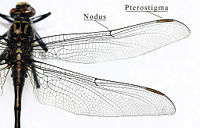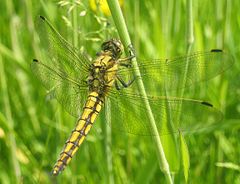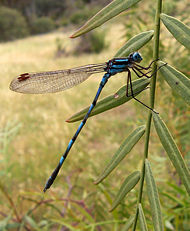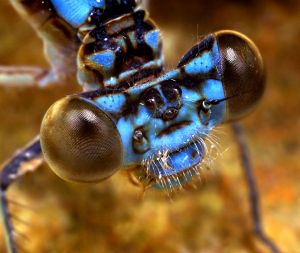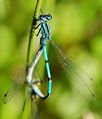Damselfly
| Damselflies | ||||||||||
|---|---|---|---|---|---|---|---|---|---|---|
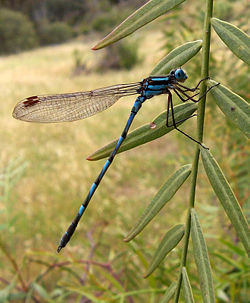 Blue Ringtail, Austrolestes annulosus
| ||||||||||
| Scientific classification | ||||||||||
| ||||||||||
|
Amphipterygidae |
The Damselfly (Suborder Zygoptera) is an insect in the Order Odonata. Damselflies are similar to dragonflies, but the adults can be differentiated by the fact that the wings of most damselflies are held along the body when at rest. Furthermore, the hindwing of the damselfly is essentially similar to the forewing, while the hindwing of the dragonfly broadens near the base, caudal to the connecting point at the body. Damselflies are also usually smaller, weaker fliers than dragonflies, and their eyes are separated.
Dragonfly is the common name for any insect belonging to the infraorder (or suborder) Anisoptera of the order Odonata, characterized by an elongated body, large multifaceted eyes, and two pairs of strong transparent wings, which at rest are typically held out to the side or out and downward. In a broader sense, "dragonfly" is used to designate any insect in Epiprocata (Bechly 1996), which is a relatively new suborder that was created and subsumes as an infraorder of the previous suborder Anisoptera, the "true dragonflies."
Overview and description
As with all members of the arthropod class Insecta, dragonflies have three pairs of jointed appendages, exposed mouth parts, an exoskeleton, a segmented abdomen that lacks any legs or wings, and one pair of antennae on the head.
Odonata is an order of insects encompassing dragonflies and damselflies, with members characterized by large, compound eyes, chewing mouth parts, a long and slender abdomen, and multi-veined wings that are typically clear or transparent. Members of Odonata characteristically have large rounded heads, legs that facilitate catching prey (other insects) in flight, two pairs of long, transparent wings that move independently, and elongated, ten-segmented abdomens.
In most families of Odonata, the wings, which are large, multi-veined, and slender, have an opaque structure on the leading edge near the tip of the wing, called the pterostigma. Males have unique secondary genitalia on the underside of the second and third abdominal segments, which are distinct from the actual genital opening located near the tip of the abdomen (Grzimek et al. 2004).
Within odonata, the two main groups are the damselflies (suborder Zygoptera) and the dragonflies (suborder Epiprocta), with true dragonflies in infraorder Anisoptera. Dragonflies tend to be large insects with four elongate, membranous wings with characteristic, net-like veins. The antennae tend to be very small.
Dragonflies are predatory insects and typically eat mosquitoes, midges, and other small insects, like flies, bees, and butterflies. They are usually found around lakes, ponds, streams, and wetlands because their larvae, known as "nymphs," are aquatic. Dragonflies are valued as a predator that helps control the populations of harmful insects, such as mosquitoes. It is because of this that dragonflies are sometimes called "mosquito hawks" in North America.
Dragonflies versus damselflies
Although generally fairly similar, dragonflies differ from damselflies (suborder Zygotpera) in several, easily recognizable traits. Dragonflies have fairly robust bodies, are strong fliers, and at rest hold their wings either out to the side or out and downward (or even somewhat forward). Damselflies tend to be less robust, even appearing rather weak in flight, and when at rest hold their wings either folded together back above the abdomen or held slightly open above (such as in the family Lestidae). Also, the hind wing of the dragonfly broadens near the base, caudal to the connecting point at the body, while the hind wing of the damselfly is essentially similar to the fore wing.
Dragonfly eyes typically occupy much of the animal's head, touching (or nearly touching) each other across the face, with notable exceptions to this being in the Petaluridae (Petaltails) and the Gomphidae (Clubtails). In damselflies, there is typically a gap between the eyes.
Both are members of the Odonata, making their life cycles similar.
Life cycle
Damselflies undergo incomplete metamorphosis, with an aquatic nymphal stage. The female lays eggs in water, sometimes in underwater vegetation, or high in trees in bromeliads and other water-filled cavities. Nymphs are carnivorous, feeding on daphnia, mosquito larvae, and various other small aquatic organisms. The gills of damselfly nymphs are large and external, resembling three fins at the end of the abdomen. After moulting several times, the winged adult emerges and eats flies, mosquitoes, and other small insects. Some of the larger tropical species are known to feed on spiders, hovering near the web and simply plucking the spider from its perch.
Gallery
- P1010762-1.jpg
Black Torrent Dart
- P1010464-1.jpg
Coromandel Marsh Dart Ceriagrion coromandelianum
Unidentified damselfly in Victoria, Australia
Mating Damselflies
See also
- Pelecinus a genus of wasp with a similar build to a damselfly.
External links
- American Rubyspot Damselfly Hetaerina americana diagnostic photos and information
- Familiar Bluet Damselfly Enallagma civile
- Emerald Spreadwing Damselfly Lestes dryas
- Stream Bluet Damselfly Enallagma exsulans
- Northern Bluet Enallagma cyathigerum
- Blue-Tailed Damsel, Asian specie.
- Stereoscopic 3d cross eye view, Damsel fly.
Credits
New World Encyclopedia writers and editors rewrote and completed the Wikipedia article in accordance with New World Encyclopedia standards. This article abides by terms of the Creative Commons CC-by-sa 3.0 License (CC-by-sa), which may be used and disseminated with proper attribution. Credit is due under the terms of this license that can reference both the New World Encyclopedia contributors and the selfless volunteer contributors of the Wikimedia Foundation. To cite this article click here for a list of acceptable citing formats.The history of earlier contributions by wikipedians is accessible to researchers here:
The history of this article since it was imported to New World Encyclopedia:
Note: Some restrictions may apply to use of individual images which are separately licensed.
